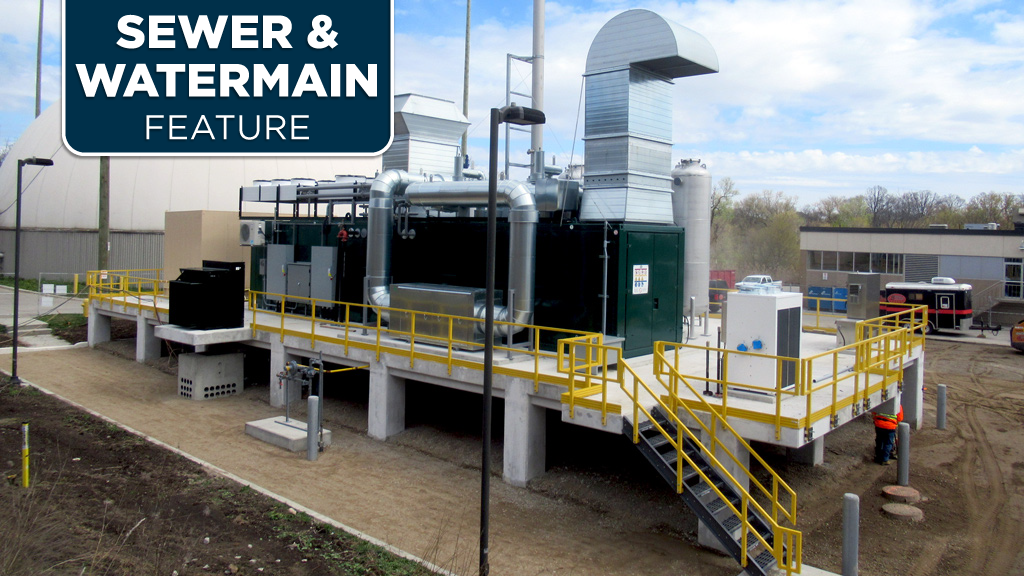The Region of Waterloo is reducing its environment footprint with a project intended to decrease electrical costs at its three largest wastewater treatment plants.
While the complications created by the global pandemic have set the construction timetable back by four to six months, a $24.1-million project to install cogeneration units at the Kitchener, Galt, and Waterloo plants is now in its final stages, with commissioning expected in the next few months.
Jacobs Engineering Group is the consultant overseeing the design and construction of the systems and W.A. Stephenson Mechanical Contractors Ltd. is the general contractor.
Comprised of pre-fabricated combined heat and power (CHP) engines, air, gas, and selective catalytic reduction systems, switchgear, and other components supplied by European and American manufacturers, the units will be fueled by biogas, a waste product expelled during the treatment process, says the region’s manager of engineering and wastewater programs, Trevor Brown.
The gas conditioning systems will remove compounds from the biogas, like moisture and chemicals, to help prevent premature wear and tear on the engines, he says.
Although some connections are still required, an 800 kilowatt engine has been installed in Kitchener, which is the Region’s largest wastewater treatment plant, with 600 kilowatt engines each at Galt and Waterloo. The engines and supporting equipment are housed within noise-dampening containers, while onsite assembly was required for the gas conditioning systems.
The project has required civil engineering site work, electrical connections and the pouring of the concrete pads the units sit on. But that work has not impacted the plants’ day-to-day plant operations, outside of short durations to make connections to the existing infrastructure.
“Cogeneration is a process enhancement,” he explains.
The units will provide supplementary electricity to power the plants at a lower cost than is available from local electrical utilities, as well as reducing their reliance on those conventional supply systems.
Another major benefit is that the heat generated from the engines will be used to preheat the digesters system which has to be heated to 35 C to maintain its effectiveness, he says.
“Anything that can be done to offset the heating requirements is an operational savings.”
Combined, the three biogas cogeneration facilities will produce about 12,000 megawatt-hours of electricity every year, which is the amount of electricity used by 1,200 houses per year.
They will also reduce the Region’s greenhouse gas emissions by about 550 tonnes of carbon dioxide each year, equivalent to taking around 115 cars off the road, he says.
In explaining why the region embarked on the project, Brown points out that wastewater treatment is a high energy user and hydro costs is “one of the biggest line items” in its operating budgets.
Annually, those costs are in the $5 million range with the Kitchener, Waterloo, and Galt plants accounting for about 75 per cent of that figure, he says.
Once the units are fully operational, they will provide an immediate return on the plants’ operating expenses in the form of reduced electrical rates. The payback on the capital investment will take between nine to 11 years, says Brown.
Planning began in 2015 with detailed engineering studies which determined the feasibility of the project, examining issues such as the sizing of the units, potential electrical savings and associate costs. Preliminary design began in the spring of 2016, with detailed design getting underway the following year.
Construction commenced in early 2019 and “continued smoothly” until mid-March of last year when the COVID-19 pandemic shutdown threw up more than a few hurdles.
New safety measures had to be quickly implemented, such as physical distancing, masking, and wellness screening, which did have an impact on scheduling and coordination of on-site contractors, which in turn has had an impact on the overall project schedule.
Early on in the pandemic, the general contractor encountered shortages in the availability of labour, materials, equipment, such as personal protection equipment.
And, with implementation of travel restrictions, border closures, and mandatory 14-day quarantine requirements, it has become difficult to arrange site visits from the suppliers to conduct the pre-commissioning and commissioning. The suppliers include 2G, the German manufacturer of the CHP engines and BioSpark, the American manufacturer of the catalytic reduction systems.
“We have has some success in getting these experts to site for this essential work. However, this continues to be an ongoing challenge.”
Asked about the technology, Brown explains that harnessing biogas to produce both electricity and heat is not new and it is being used around the globe, mostly at large facilities due to economies of scale.
“There are wastewater facilities in the world that are now operating 100 per cent off the electrical grid and generate all the electricity they need for their operations.”




Recent Comments